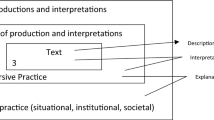Abstract
We explore a conceptual frame for analyzing mathematics classroom discourse to understand the way authority is at work. This case study of a teacher moving from a school where he is known to a new setting offers us the opportunity to explore the use of the conceptual frame as a tool for understanding how language practice and authority relate in a mathematics classroom. This case study illuminates the challenges of establishing disciplinary authority in a new context while also developing the students’ sense of authority within the discipline. To analyze the communication in the teacher’s grade 12 class in the first school and grade 9 class early in the year at the new school, we use the four categories of positioning drawn from our earlier analysis of pervasive language patterns in mathematics classrooms—personal authority, discourse as authority, discursive inevitability, and personal latitude.
Similar content being viewed by others
Notes
All names are pseudonyms.
References
Alrø, H., & Skovsmose, O. (2002). Dialogue and learning in mathematics education: Intention, reflection, critique. Dordrecht: Kluwer.
Amit, M., & Fried, M. (2005). Authority and authority relations in mathematics education: A view from an 8th grade classroom. Educational Studies in Mathematics, 58, 145–168.
Biber, D., Conrad, S., & Cortes, V. (2004). If you look at...: Lexical bundles in university teaching and textbooks. Applied Linguistics, 25(3), 371–405.
Bishop, A. (1988). Mathematical enculturation: A cultural perspective in mathematics education. Dordrecht: D. Reidel Publishing Company.
Boaler, J. (Ed.). (2003). Studying and capturing the complexity of practice—the case of the “dance of agency”: Proceedings of the 27 th Conference of the International Group for the Psychology of Mathematics Education held jointly with the 25th Conference of PME-NA, Honolulu, Hawaii (Vol. I, pp. 3–16).
Cobb, P., Yackel, E., & Wood, T. (1993). Theoretical orientation. In D. Dillon (Ed.), Rethinking elementary school mathematics: Insights and issues, Monograph #6. NCTM: Reston, VA.
Herbel-Eisenmann, B. (2009). Negotiation of the “presence of the text”: How might teachers’ language choices influence the positioning of the textbook? In J. Remillard, B. Herbel-Eisenmann, & G. Lloyd (Eds.), Mathematics teachers at work: Connecting curriculum materials and classroom instruction (pp. 134–151). New York: Routledge.
Herbel-Eisenmann, B., & Wagner, D. (2010). Appraising lexical bundles in mathematics classroom discourse: Obligation and choice. Educational Studies in Mathematics, 75, 43–63.
Herbel-Eisenmann, B., Wagner, D., & Cortes, V. (2010). Lexical bundle analysis in mathematics classroom discourse: The significance of stance. Educational Studies in Mathematics, 75(1), 23–42.
Hufferd-Ackles, K., Fuson, K. C., & Sherin, M. G. (2004). Describing levels and components of a math-talk learning community. Journal for Research in Mathematics Education, 35(2), 81.
Martin, J., & White, P. (2005). The language of evaluation: appraisal in English. New York: Palgrave.
Morgan, C. (1998). Writing mathematically: The discourse of investigation. Bristol, PA: Falmer Press.
Oyler, C. (1996). Making room for students: Sharing teaching authority in room 104. New York: Teachers College Press.
Pace, J. (2003). Using ambiguity and entertainment to win compliance in a lower-level U.S. history class. Journal of Curriculum Studies, 35, 83–110.
Pace, J., & Hemmings, A. (2007). Understanding authority in classrooms: A review of theory, ideology, and research. Review of Educational Research, 77, 4–27.
Pickering, A. (1995). The mangle of practice: Time, agency and science. Chicago: University of Chicago.
Pimm, D. (1987). Speaking mathematically. London: Routledge and Kegan Paul.
Rittenhouse, P. (1998). The teacher’s role in mathematical conversation: Stepping in and stepping out. In Lampert & Blunk (Eds.) Talking mathematics in schools: Studies of teaching and learning. New York: Cambridge University Press.
Roesken, B., Hannula, M., & Pehkonen, E. (2011). Dimensions of students’ views of themselves as learners of mathematics. ZDM-The International Journal on Mathematics Education, 43, 497–506.
Rowland, T. (1992). Pointing with pronouns. For the Learning of Mathematics, 12(2), 44–48.
Schoenfeld, A. (1992). Reflections on doing and teaching mathematics. In A. Schoenfeld (Ed.), Mathematical thinking and problem solving (pp. 53–70). Hillsdale, NJ: Erlbaum.
Skemp, R. (1979). Intelligence, learning, and action. New York: John Wiley and Sons.
Skovsmose, O. (2001). Landscapes of investigation. ZDM-The International Journal on Mathematics Education, 33(4), 123–132.
Wagner, D. (2012). Opening mathematics texts: Resisting the seduction. Educational Studies in Mathematics, 80(1–2), 153–169.
Wagner, D., & Herbel-Eisenmann, B. (2008). ‘Just don’t’: The suppression and invitation of dialogue in the mathematics classroom. Educational Studies in Mathematics, 67(2), 143–157.
Wagner, D., & Herbel-Eisenmann, B. (2009). Re-mythologizing mathematics through attention to classroom positioning. Educational Studies in Mathematics, 72, 1–15.
Yackel, E., & Cobb, P. (1996). Sociomathematical norms, argumentation, and autonomy in mathematics. Journal for Research in Mathematics Education, 27(4), 458–477.
Yin, R. (2006). Case study methods. In J. Green, G. Camilli, & P. Elmore (Eds.), Handbook of complementary methods in educational research (pp. 111–122). Mahwah, NJ: LEA & AERA.
Acknowledgments
This research was supported by the Social Sciences and Humanities Research Council of Canada, as part of a grant entitled “Positioning and Authority in Mathematics Classrooms.”
Author information
Authors and Affiliations
Corresponding author
Rights and permissions
About this article
Cite this article
Wagner, D., Herbel-Eisenmann, B. Identifying authority structures in mathematics classroom discourse: a case of a teacher’s early experience in a new context. ZDM Mathematics Education 46, 871–882 (2014). https://doi.org/10.1007/s11858-014-0587-x
Accepted:
Published:
Issue Date:
DOI: https://doi.org/10.1007/s11858-014-0587-x




